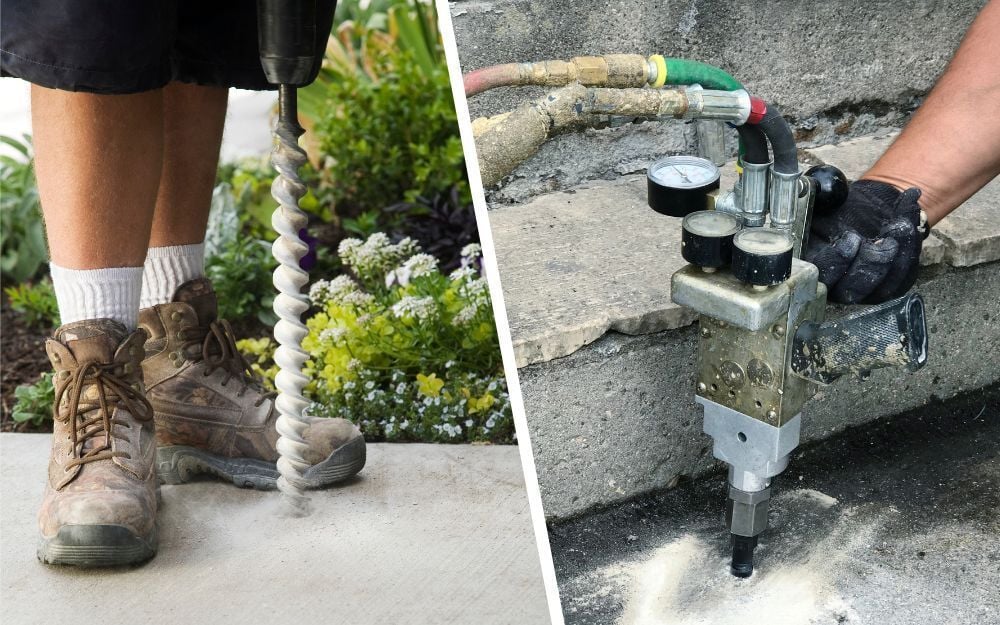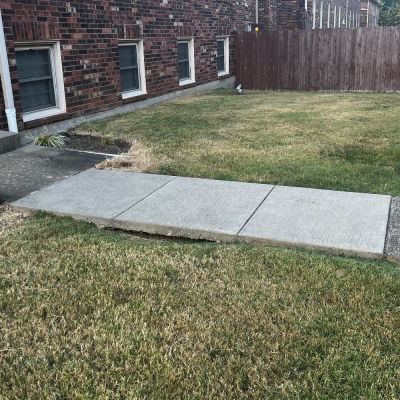Polyjacking vs. Mudjacking: Which Is Best for Your Sinking Concrete?
June 27th, 2023 | 5 min. read
By Sarah Etler

Learn whether polyjacking or mudjacking is a better fit for your concrete's specific needs.
If you've been researching concrete leveling methods, you may have come across terms like "polyjacking" and "mudjacking." Both techniques save money and time by preserving your existing concrete and avoiding expensive replacement, but they have some differences.
While some companies may say that one method is far superior to the other, here at A-1 Concrete Leveling, we believe in providing the whole picture rather than only offering a one-size-fits-all solution.
For this reason, we want to provide you with all the necessary information to make the best decision for your unique situation.
At A-1, we offer polyjacking and stone slurry grout concrete lifting services, but we recognize that mudjacking is a widely available option that still achieves the goal of even concrete, making it worth considering.
In this comprehensive guide, we’ll define and compare polyjacking and mudjacking so that you can get a feel for whether one or the other is best for your home.
What Is Polyjacking?
Polyjacking, also called “foam leveling,” “poly leveling,” or “foam injection leveling,” is a newer form of concrete leveling that uses a liquid foam injected through small holes drilled in a settled slab.
Once the foam is injected under the slab, it undergoes a chemical reaction that causes it to expand. As it expands, it fills the voids and puts enough pressure on the slab to lift it back up into a level position.
The foam hardens in less than an hour, leaving you with level, stabilized concrete.
Polyjacking Strengths & Weaknesses
Polyjacking Strengths
There are quite a few positives that come with polyjacking, including:
-
Drill Hole Size
The drill holes required for foam leveling are smaller than any other concrete leveling method at ⅝” in diameter. This means they will be less noticeable after the holes are filled and the repair is complete.
-
Faster Injection Speed
The expanding foam material can be injected quickly into the void below a settled slab. This may allow for a quicker repair overall where large voids are present.
-
Accessibility
Because polyjacking equipment is housed on portable units, it can be taken virtually anywhere.
-
Quick Cure Time
The foam used in polyjacking repairs can harden and be ready to use in as little as 15 minutes to an hour. Mudjacking is typically ready for foot traffic immediately but not for normal use until after 24 hours.
Polyjacking Weaknesses
-
Higher Cost
The expanding polyurethane foam used for polyjacking is a more expensive material, which usually means this type of leveling costs more overall.
-
Less Control
Due to the nature of expanding foam, leveling technicians have less control over where and how much the foam expands. This may lead to over-lifting or unexpected outcomes.
-
Uncertain Void Fill
Injection foam leveling may not be able to fill all voids under a settled slab, which can lead to a weaker repair.
-
Potential Hazards
In order to lift the sunken concrete slab, the foam used for foam leveling undergoes a chemical reaction and expands. During this chemical reaction, there is a risk of melting or explosions.
Related Resource: The Pros & Cons of Foam Injection Concrete Leveling
What Is Mudjacking?
Mudjacking is a concrete leveling process that works by pumping a “mud” mixture of soil, sand, water, and sometimes Portland cement at a high speed and pressure through holes drilled in the settled slab.
As the mixture is pumped below the surface, it spreads out and fills voids, eventually creating enough pressure to lift the slab into a level position.
Once the mudjacking is complete, the drill holes are sealed off and the area can be used like normal again after 24 hours.
With over 50 locations throughout the US, we have found that mudjacking means different things in different regions. Mudjacking is often confused with stone slurry grout leveling, which is a different type of concrete leveling that uses lower pressure and smaller drill holes.
Mudjacking Strengths & Weaknesses
-
Strength and Durability
When performed correctly by a knowledgeable concrete leveling company, mudjacking can be a strong, long-lasting repair.
-
Lower Cost
Mudjacking repairs generally cost less than polyjacking or stone slurry grout leveling repairs.
-
Accessibility
Like polyjacking, mudjacking equipment is often housed on a mobile cart, which allows for repairs in hard-to-reach areas.
Mudjacking Weaknesses
-
Drill Hole Size
The mudjacking process requires the largest drill hole size of all three concrete leveling methods: 2” in diameter. This large hole is to accommodate the high pressure needed to pump the material under the slab.
-
High Pressure
Mudjacking works to raise concrete by pumping in the material at a high pressure, but this high pressure can prevent all voids from being filled, which may lead to a weaker repair that does not last as long.
-
Less Control
Like polyjacking, it can be hard to control mudjacking repairs and over-lift the settled slabs. In the case of mudjacking, this is due to the higher pumping speed and pressure.
Related Resource: The Pros & Cons of Mudjacking
Does Weight Matter?
When researching polyjacking and mudjacking, you may come across companies making claims that the weight of the mudjacking mixture causes the underlying soil to resettle and the concrete to sink again, but soil settlement is a natural process that occurs regardless of the concrete leveling method used.
Whether you opt for polyjacking or mudjacking, if the soil has not had the proper time to compact before the leveling repair is performed or the soil is exposed to factors that cause erosion, the lifted concrete may settle again.
Related Resource: Why Concrete Settles
As you can see in the photo below, there is no leveling compound adding weight to the soil below the sidewalk, but the soil is still settling.

Reducing the Chances of Resettled Slabs
To minimize the potential for resettling with both mudjacking and polyjacking repairs, it’s best to allow the soil to settle fully before leveling the concrete (usually around 5 years after new concrete is poured). Additionally, it is crucial to address any sources of erosion that could wash the soil away and cause the slabs to sink again.
When to Choose Polyjacking vs. Mudjacking
When to Choose Polyjacking
Polyjacking is better suited for places with decorative details that would be impacted by the large drill holes left by mudjacking, like stamped concrete.
It’s also best to use polyjacking for smaller repairs, due to the higher material cost that ultimately means a more expensive repair.
In general, it’s also better to avoid using polyjacking to level weight-bearing areas, like porches with columns that support a roof, for example.
When to Choose Mudjacking
Because mudjacking is usually the least expensive option when it comes to concrete leveling, it’s a great choice if you’re looking for a lower price and don’t mind the larger drill holes.
Mudjacking is also recommended over polyjacking for areas that will support a lot of weight.
As we mentioned previously, when done correctly by a knowledgeable concrete leveler, mudjacking can be a durable and long-lasting solution.
Which Repair Method Is Right for You?
At the end of the day, both polyjacking and mudjacking can lift settled concrete for a fraction of the price of full concrete replacement.
When thinking about which concrete leveling method to go with, it’s important to weigh the pros and cons of each method. Here are dedicated articles that discuss the pros and cons of all three concrete leveling methods:
- Polyurethane Foam Concrete Leveling: The Pros & Cons
- Mudjacking: The Pros & Cons
- Stone Slurry Grout Concrete Leveling: The Pros & Cons
A-1 Concrete Leveling has 30+ years of experience repairing and preserving concrete, and our goal is to use that experience to inform you as much as possible about all of your options in order to help you make the best decision for your concrete.
While not discussed in this article, you should consider stone slurry grout leveling as an option to lift your settled concrete. Unlike mudjacking, we do perform both stone slurry grout leveling and polyjacking here at A-1.
If you’re interested in seeing what concrete leveling can do for your settled concrete, click the link below to schedule a free onsite concrete inspection and cost estimate:
Click Here to Find Your Nearest Location and Receive a FREE Estimate
Sarah Etler joined A-1 Concrete Leveling after receiving her Bachelor of Arts degree in English from Northern Kentucky University. As A-1's Content Marketing Manager, she works closely with industry experts to produce content that will best answer questions related to concrete repair and maintenance practices. Sarah loves living a life full of discovery and is excited every day to see what new things she can learn and share with those around her.